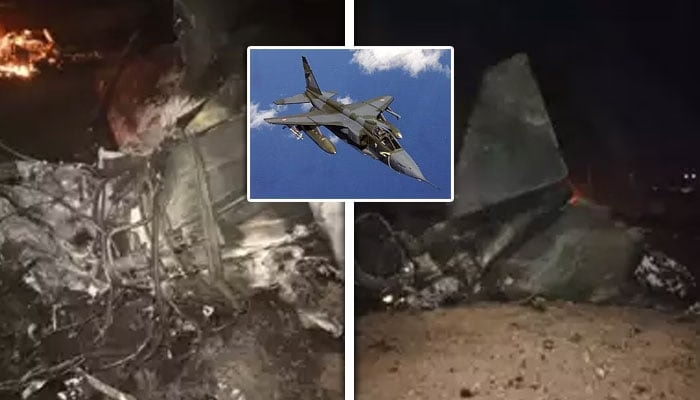A tragic incident unfolded in Gujarat as an Indian Air Force (IAF) Jaguar fighter jet crashed in Jamnagar. The crash took place in Suwarda village, approximately 12 kilometers from Jamnagar city. While one pilot managed to eject safely, a search operation is currently underway for the other. The incident has once again sparked concerns over the safety standards of the Indian Air Force and the country’s aging defense fleet.
Routine Training Flight Ends in Disaster
According to Indian Air Force officials, the two-seater Jaguar aircraft was conducting a routine training flight when the crash occurred. Shortly after the crash, the aircraft caught fire, raising further concerns regarding the IAF’s maintenance and operational procedures. The cause of the crash is yet to be determined, and an official investigation has been launched to ascertain the reasons behind the incident.
This accident comes on the heels of another alarming trend: frequent crashes involving Indian Air Force fighter jets. Just last month, two IAF aircraft, including a Jaguar fighter jet, crashed in separate incidents. Moreover, in November 2024, a MiG-29 fighter jet crashed near Uttar Pradesh, highlighting a disturbing pattern of accidents.
Recurring Crashes Raise Concerns Over Indian Air Force Safety Standards
India’s defense sector has faced significant scrutiny over the years, with experts pointing to outdated aircraft, insufficient maintenance, and a lack of modernization as key contributors to the increasing number of crashes. Defense analysts argue that these incidents highlight major flaws in India’s defense system, further exacerbated by poor policy decisions under Prime Minister Narendra Modi’s government.
Repeated accidents involving fighter jets have cast a shadow over the Indian Air Force’s combat readiness and operational efficiency. The aging fleet, particularly aircraft such as the Jaguar and MiG-29, is believed to be a major factor behind these crashes. The Jaguar fighter jet, initially inducted into the Indian Air Force in the late 1970s, is now considered outdated by modern military aviation standards. While upgrades have been attempted, the aircraft’s age and lack of advanced technological integration make it prone to failures.
Defense Experts Blame Modi Government’s Policies
Defense analysts have raised concerns about the declining standards of the Indian Air Force, attributing it to failed policies, corruption, and mismanagement under the Modi government. Experts claim that the administration’s reluctance to modernize the air fleet efficiently has led to repeated mishaps.
Additionally, procurement delays, budget cuts, and corruption scandals have plagued India’s defense sector, making it difficult to address these critical issues. While the Indian government has initiated programs to replace outdated fighter jets, progress has been slow, leaving pilots to operate under risky conditions with aging equipment.
A senior defense analyst commented, India’s fighter jet crashes are no longer isolated incidents but part of a larger issue within the defense structure. The government’s failure to prioritize safety and modernization has led to repeated accidents, endangering lives and compromising national security.
The Jaguar Fighter Jet: An Aging Workhorse of the IAF
The Jaguar is a twin-engine ground-attack aircraft, widely used by the Indian Air Force for strike missions. Available in single and two-seater variants, the Jaguar has played a significant role in India’s defense for decades. However, with newer and more advanced fighter jets being developed worldwide, the Jaguar’s relevance in modern warfare is diminishing.
Despite numerous upgrades over the years, the aircraft still lacks advanced avionics and safety features found in modern fighter jets. This raises the question of whether the Indian government should accelerate its efforts to replace aging jets with newer, more efficient aircraft.
Urgent Need for Modernization
To prevent further tragedies and improve the operational capability of the Indian Air Force, experts suggest the following measures:
- Modernization of the Fleet: Accelerating the acquisition of advanced fighter jets such as the Rafale and Tejas to replace aging aircraft like the Jaguar and MiG-29.
- Improved Maintenance and Safety Protocols: Implementing strict maintenance schedules and upgrading safety measures to prevent technical failures.
- Enhanced Pilot Training Programs: Providing state-of-the-art training facilities and simulation-based programs to prepare pilots for emergency scenarios.
- Addressing Corruption and Policy Failures: Ensuring transparency in defense deals and fast-tracking procurement processes to enhance national security.
The latest crash of an Indian Air Force Jaguar fighter jet in Jamnagar has once again raised serious concerns about the state of India’s defense aviation sector. With repeated crashes in recent months, the urgent need for modernization, better maintenance protocols, and strategic policy changes cannot be ignored.
As India continues to face regional security challenges, ensuring the safety and efficiency of its air force should be a top priority. Unless immediate action is taken, the country risks further compromising its defense capabilities and endangering the lives of its pilots. The Modi government must address these pressing issues before the situation worsens, and India’s air power suffers irreversible setbacks.



